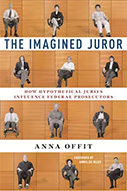The Imagined Juror: How Hypothetical Juries Influence Federal Prosecutors

Author: Anna Offit
Publisher: NYU Press: New York, NY, 2022. 192 pages.
Reviewer: Jeffrey Bellin
Criminal justice scholars commonly lament the absence of information about prosecutors. We know that police arrest people and judges impose sentences. But prosecutors occupy an uncertain space in between. Prosecutors’ actions and decisions are often described as occurring in a ‘black box.’
A curious aspect of these complaints is that prosecutors are not a mysterious biological process or a peculiar cell structure. To the extent we don’t understand what prosecutors are doing, we can ask them, a strategy that has been employed to great effect over the years by scholars such as Ron Wright and Kay Levine. Anna Offit adds a valuable contribution to this genre in her new book, The Imagined Juror, which presents the results of a fascinating ethnographic study Offit conducted inside an unnamed United States Attorney’s Office.
Offit was granted comprehensive access to the office and its Assistant United States Attorneys (AUSAs). She explains that, during “the first months of fieldwork,” she interviewed over 133 AUSAs, establishing a foundation for “countless” informal conversations in the following years (p. 10). Offit does not simply describe the official proceedings she witnessed. Offit chronicles the behind-the-scenes discussions that readers will be most interested in, where AUSAs discussed whether to prosecute a case, what type of plea deal to offer, and how to select jurors and conduct trials. This degree of access allows Offit to present an invaluable depiction of what goes on inside the black box—precisely the type of information scholars seek.
Without giving away too much of the plot, those looking for scandal, or even just bad behavior, will be disappointed. The AUSAs Offit chronicles come across as conscientious attorneys trying, within the narrow confines of their assigned roles, to accomplish a difficult directive: “doing justice” (p. 10). The AUSAs may come to the wrong conclusions but it is not obvious, from Offit’s reports, that this is because they are asking the wrong questions.
Perhaps Offit’s most surprising finding, and the one she adopts as the theme of her book, is that the AUSAs frame their decision-making processes around a perception of how hypothetical jurors would react to a case. Thus, an AUSA might push to dismiss a case that, while legally sound, will not appeal to jurors due to a perception of unfairness. One AUSA, for example, rejects a case because the investigating officer used a heavy-handed surveillance tactic (an airplane) that seemed disproportionate (“out of synch”) to the seriousness of the offense (p. 43). Similarly, the AUSAs in another case rule out a potential trial tactic (calling a defendant’s family member to testify) that, while legally permitted, could come across to jurors as overbearing. Offit offers sophisticated insight into why the prosecutors use this framing. But even at the most superficial level, these ubiquitous references to imagined jurors are surprising because there are so few actual jurors.
Offit finds that AUSAs continually frame their decision-making process around what will happen at a jury trial despite the low percentage of federal convictions that result from trial (2%). In one of the most compelling (to me) explanations as to why this might be, Offit reports that some AUSAs described anticipating trial as akin to “preparing for an emergency” (p. 46). Since jury trials did occur and it was impossible to know with certainty which cases would go to trial, the AUSAs appeared to feel the need to treat a trial as a possibility in every case. The AUSAs’ focus on potential jury reactions is not the only surprising finding Offit reports. Offit’s descriptions of the prosecutors’ approach to jury selection are reason alone to read the book.
Critics may discount Offit’s findings on various grounds. One obvious critique is that we cannot simply believe prosecutors when they tell us what they are doing. This is the value of Offit’s ethnographic study. Offit, who has a PhD in anthropology, did not just interview the prosecutors she describes. For a time, she became one of them. Offit “made friends, attended retirement parties and baby showers, went bowling, visited homes” and more (p. 10). Presumably, Offit’s ability to earn the trust of those she observed makes her account more reliable. It certainly seems plausible that the AUSAs Offit interacted with would have more trouble misleading her than they would a typical observer. In addition, by being present for the cases as they unfolded, Offit could (and does) chronicle the degree to which the AUSAs’ rhetoric matched their actions. Thus, we need not trust the prosecutors to find Offit’s findings valuable, we only need to trust her. And to be clear, Offit does not take the AUSA’s accounts at face value but applies a sharp and often critical analytical lens to those accounts.
For what it’s worth, as a former AUSA myself, I found Offit’s reporting rang true. In fact, I have often been puzzled by the air of mystery surrounding prosecutors and their decisions. To my mind, the difficulty in studying prosecutors is not that we don’t know what they are doing or why. The real mystery is we don’t know what prosecutors are supposed to be doing. Offit explores this theme, noting that the generic guidance that stands in for a guiding prosecutorial principle, ‘do justice,’ is devoid of specifics, leaving prosecutors (and their critics) with little guidance in the hard cases. In addition, prosecutors do not operate in a vacuum. Consequently, even if we settled on a clear metric for measuring justice, we would still struggle to separate out prosecutors’ proper role in preventing injustice when that injustice is spearheaded by other actors, such as police, legislators, judges, or jurors.
To highlight just one aspect of this dilemma, the AUSAs Offit describes seem aware of the problems of racism in the system. In fact, she mentions that “22 percent of my interlocutors were people of color” (p. 7). Yet even if the prosecutors Offit observed purged racism from their own actions that does not mean that the cases they participated in would be devoid of racial implications. For example, Offit’s AUSAs regularly reference gun cases. Thanks to a federal law enacted in 1968, gun possession can be prosecuted in federal court if the person charged has a prior felony conviction. The cases are generally simple to prove. Consequently, the federal prosecutor’s role in doing justice in a typical gun possession case may look quite narrow and race neutral.
But the harder question is whether these cases should be federally prosecuted at all, a question that becomes more pointed when we look at the big picture. In 2018, there were 6,719 federal convictions for gun possession with a prior felony conviction—nearing 10% of all the federal convictions that year. Almost every offender (97.6%) was sentenced to prison, with an average sentence of over five years; 54% of those convicted of the offense were Black (U.S. Sentencing Commission, 2018). If one views these statistics as evidence of injustice, AUSAs are part of that injustice. But short of refusing to prosecute gun cases altogether, a choice the AUSAs seem to feel they do not have the discretion to make, it is not obvious what we should expect AUSAs to do with these cases. There are other areas of similar tension including, most prominently, criminal immigration and drug cases where macro-level questions about the wisdom of these laws (and their severity) overwhelm micro-level questions about the handling of individual cases.
Perhaps the most important caveat for readers of The Imagined Juror is that Offit studied only one kind of prosecutor, and the most peculiar: federal prosecutors. Compared to their state counterparts, federal prosecutors have more resources, more time, fewer cases typically concerning a small set of federal crimes, go to trial less often, and rarely ‘lose.’ Offit’s findings would be different and perhaps even more informative had she conducted her study in a local District Attorney’s office in a major city or a small office in a rural county. That is less a criticism, however, than an appeal for a sequel or two.
Caveats aside, one of the best ways to learn about prosecutors is to engage with them with an open mind (and a notebook). Offit does just that. The Imagined Juror is an unquestionably valuable contribution to the literature on prosecutors. Offit opens a window into the inner workings of a federal prosecutor’s office at a time when interest in prosecutors is at its height. The Imagined Juror answers the important question of what prosecutors do and why. Or, at least, it tells us what one set of federal prosecutors believe they are doing. These kinds of descriptive accounts are critical to developing normative accounts of what prosecutors should be doing and then comparing what they do to that ideal. Understanding prosecutors is important and fairly evaluating them better still. For the goal is not just to learn about prosecutors but to push them to improve a flawed system rather than simply toil within it.
References:
U.S. Sentencing Commission. 2018. Quick Facts: Felon in Possession of a Firearm. Retrieved from https://www.ussc.gov/sites/default/files/pdf/research-and-publications/quick-facts/Felon_In_Possession_FY18.pdf.
Jeffrey Bellin is a professor at William & Mary Law School. His book Mass Incarceration Nation: How the United States Became Addicted to Prisons and Jails and How it Can Recover is forthcoming with Cambridge University Press.


